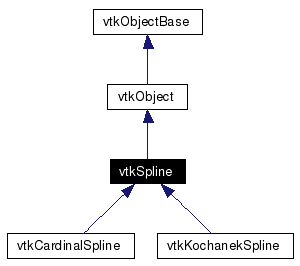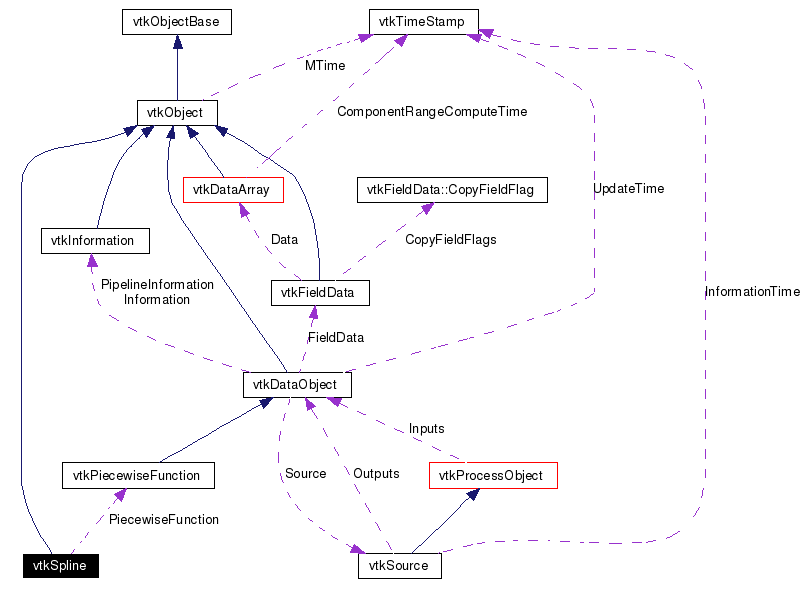vtkSpline Class Reference
#include <vtkSpline.h>
Inheritance diagram for vtkSpline:
 [legend]Collaboration diagram for vtkSpline:
[legend]Collaboration diagram for vtkSpline: [legend]List of all members.
[legend]List of all members.
Detailed Description
spline abstract class for interpolating splines
vtkSpline interpolates a set of data points (i.e., interpolation means that the spline passes through the points). vtkSpline is an abstract class: its subclasses vtkCardinalSpline and vtkKochenekSpline do the interpolation. Note that this spline maps the 1D parametric coordinate t into a single value x. Thus if you want to use the spline to interpolate points (i.e. x[3]), you have to create three splines for each of the x-y-z coordinates. Fortunately, the vtkParametricSpline class does this for you.
Typically a spline is used by adding a sequence of parametric coordinate / data (t,x) values followed by use of an evaluation function (e.g., vtkCardinalSpline::Evaluate()). Since these splines are 1D, a point in this context is an independent / dependent variable pair.
Splines can also be set up to be closed or open. Closed splines continue from the last point to the first point with continuous function and derivative values. (You don't need to duplicate the first point to close the spline, just set ClosedOn.)
This implementation of splines does not use a normalized parametric coordinate. If the spline is open, then the parameter space is (tMin <= t <= tMax) where tMin and tMax are the minimum and maximum parametric values seen when performing AddPoint(). If the spline is closed, then the parameter space is (tMin <= t <= (tMax+1)) where tMin and tMax are the minimum and maximum parametric values seen when performing AddPoint(). Note, however, that this behavior can be changed by explicitly setting the ParametricRange(tMin,tMax). If set, the parameter space remains (tMin <= t <= tMax), except that additions of data with parametric values outside this range are clamped within this range.
- See also:
- vtkCardinalSpline vtkKochenekSpline vtkParametricSpline vtkParametricFunctionSource
Definition at line 60 of file vtkSpline.h.
Member Typedef Documentation
Constructor & Destructor Documentation
| vtkSpline::vtkSpline |
( |
|
) |
[protected] |
|
| vtkSpline::~vtkSpline |
( |
|
) |
[protected] |
|
Member Function Documentation
| virtual const char* vtkSpline::GetClassName |
( |
|
) |
[virtual] |
|
| static int vtkSpline::IsTypeOf |
( |
const char * |
type |
) |
[static] |
|
|
|
Return 1 if this class type is the same type of (or a subclass of) the named class. Returns 0 otherwise. This method works in combination with vtkTypeRevisionMacro found in vtkSetGet.h.
Reimplemented from vtkObject.
Reimplemented in vtkCardinalSpline, and vtkKochanekSpline. |
| virtual int vtkSpline::IsA |
( |
const char * |
type |
) |
[virtual] |
|
|
|
Return 1 if this class is the same type of (or a subclass of) the named class. Returns 0 otherwise. This method works in combination with vtkTypeRevisionMacro found in vtkSetGet.h.
Reimplemented from vtkObject.
Reimplemented in vtkCardinalSpline, and vtkKochanekSpline. |
| void vtkSpline::PrintSelf |
( |
ostream & |
os, |
|
|
vtkIndent |
indent |
|
) |
[virtual] |
|
|
|
Methods invoked by print to print information about the object including superclasses. Typically not called by the user (use Print() instead) but used in the hierarchical print process to combine the output of several classes.
Reimplemented from vtkObject.
Reimplemented in vtkCardinalSpline, and vtkKochanekSpline. |
| void vtkSpline::SetParametricRange |
( |
double |
tMin, |
|
|
double |
tMax |
|
) |
|
|
|
|
Set/Get the parametric range. If not set, the range is determined implicitly by keeping track of the (min,max) parameter values for t. If set, the AddPoint() method will clamp the t value to lie within the specified range. |
| void vtkSpline::SetParametricRange |
( |
double |
tRange[2] |
) |
[inline] |
|
| void vtkSpline::GetParametricRange |
( |
double |
tRange[2] |
) |
const |
|
| virtual void vtkSpline::SetClampValue |
( |
int |
|
) |
[virtual] |
|
|
|
Set/Get ClampValue. If On, results of the interpolation will be clamped to the min/max of the input data. |
| virtual int vtkSpline::GetClampValue |
( |
|
) |
[virtual] |
|
|
|
Set/Get ClampValue. If On, results of the interpolation will be clamped to the min/max of the input data. |
| virtual void vtkSpline::ClampValueOn |
( |
|
) |
[virtual] |
|
|
|
Set/Get ClampValue. If On, results of the interpolation will be clamped to the min/max of the input data. |
| virtual void vtkSpline::ClampValueOff |
( |
|
) |
[virtual] |
|
|
|
Set/Get ClampValue. If On, results of the interpolation will be clamped to the min/max of the input data. |
| virtual void vtkSpline::Compute |
( |
|
) |
[pure virtual] |
|
| virtual double vtkSpline::Evaluate |
( |
double |
t |
) |
[pure virtual] |
|
| int vtkSpline::GetNumberOfPoints |
( |
|
) |
|
|
|
|
Return the number of points inserted thus far. |
| void vtkSpline::AddPoint |
( |
double |
t, |
|
|
double |
x |
|
) |
|
|
|
|
Add a pair of points to be fit with the spline. |
| void vtkSpline::RemovePoint |
( |
double |
t |
) |
|
|
|
|
Remove a point from the data to be fit with the spline. |
| void vtkSpline::RemoveAllPoints |
( |
|
) |
|
|
|
|
Remove all points from the data. |
| virtual void vtkSpline::SetClosed |
( |
int |
|
) |
[virtual] |
|
|
|
Control whether the spline is open or closed. A closed spline forms a continuous loop: the first and last points are the same, and derivatives are continuous. |
| virtual int vtkSpline::GetClosed |
( |
|
) |
[virtual] |
|
|
|
Remove all points from the data. |
| virtual void vtkSpline::ClosedOn |
( |
|
) |
[virtual] |
|
|
|
Remove all points from the data. |
| virtual void vtkSpline::ClosedOff |
( |
|
) |
[virtual] |
|
|
|
Remove all points from the data. |
| virtual void vtkSpline::SetLeftConstraint |
( |
int |
|
) |
[virtual] |
|
|
|
Set the type of constraint of the left(right) end points. Four constraints are available: 0: the first derivative at left(right) most point is determined from the line defined from the first(last) two points. 1: the first derivative at left(right) most point is set to Left(Right)Value. 2: the second derivative at left(right) most point is set to Left(Right)Value. 3: the second derivative at left(right)most points is Left(Right)Value times second derivative at first interior point. |
| virtual int vtkSpline::GetLeftConstraint |
( |
|
) |
[virtual] |
|
|
|
Set the type of constraint of the left(right) end points. Four constraints are available: 0: the first derivative at left(right) most point is determined from the line defined from the first(last) two points. 1: the first derivative at left(right) most point is set to Left(Right)Value. 2: the second derivative at left(right) most point is set to Left(Right)Value. 3: the second derivative at left(right)most points is Left(Right)Value times second derivative at first interior point. |
| virtual void vtkSpline::SetRightConstraint |
( |
int |
|
) |
[virtual] |
|
|
|
Set the type of constraint of the left(right) end points. Four constraints are available: 0: the first derivative at left(right) most point is determined from the line defined from the first(last) two points. 1: the first derivative at left(right) most point is set to Left(Right)Value. 2: the second derivative at left(right) most point is set to Left(Right)Value. 3: the second derivative at left(right)most points is Left(Right)Value times second derivative at first interior point. |
| virtual int vtkSpline::GetRightConstraint |
( |
|
) |
[virtual] |
|
|
|
Set the type of constraint of the left(right) end points. Four constraints are available: 0: the first derivative at left(right) most point is determined from the line defined from the first(last) two points. 1: the first derivative at left(right) most point is set to Left(Right)Value. 2: the second derivative at left(right) most point is set to Left(Right)Value. 3: the second derivative at left(right)most points is Left(Right)Value times second derivative at first interior point. |
| virtual void vtkSpline::SetLeftValue |
( |
double |
|
) |
[virtual] |
|
|
|
The values of the derivative on the left and right sides. The value is used only if the left(right) constraint is type 1-3. |
| virtual double vtkSpline::GetLeftValue |
( |
|
) |
[virtual] |
|
|
|
The values of the derivative on the left and right sides. The value is used only if the left(right) constraint is type 1-3. |
| virtual void vtkSpline::SetRightValue |
( |
double |
|
) |
[virtual] |
|
|
|
The values of the derivative on the left and right sides. The value is used only if the left(right) constraint is type 1-3. |
| virtual double vtkSpline::GetRightValue |
( |
|
) |
[virtual] |
|
|
|
The values of the derivative on the left and right sides. The value is used only if the left(right) constraint is type 1-3. |
| unsigned long vtkSpline::GetMTime |
( |
|
) |
[virtual] |
|
|
|
Return the MTime also considering the Piecewise function.
Reimplemented from vtkObject. |
| virtual void vtkSpline::DeepCopy |
( |
vtkSpline * |
s |
) |
[virtual] |
|
| double vtkSpline::ComputeLeftDerivative |
( |
|
) |
[protected] |
|
| double vtkSpline::ComputeRightDerivative |
( |
|
) |
[protected] |
|
| int vtkSpline::FindIndex |
( |
int |
size, |
|
|
double |
t |
|
) |
[protected] |
|
Member Data Documentation
The documentation for this class was generated from the following file:
Generated on Tue Jan 22 00:18:00 2008 for VTK by
 1.4.3-20050530
1.4.3-20050530



 1.4.3-20050530
1.4.3-20050530